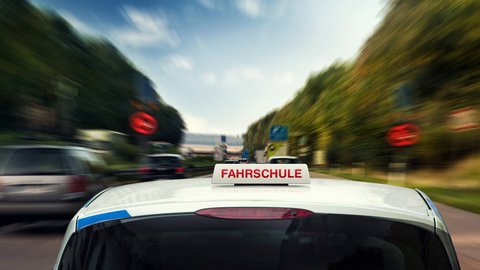Direction signs
Indicative signs give special instructions for facilitating traffic. They may also contain bids or prohibitions. The characters are usually located where or from where you have to follow this order. Otherwise, an additional symbol will be affixed.
Priority signs
The most important priority signs
One-time right of way
The StVO traffic sign with the official No. 301 gives you one-time right of way at the next intersection. In urban areas, it is located directly at the intersection to which it applies. Out of town, the sign points you to your right of way 150m to 200m before the intersection.
Priority road
The sign gives you up to the sign "give way", "Stop. Give right of way" or "End of priority road" give right of way. Outside built-up areas you are not allowed to park on a priority road. So go to parking on parking lots, side lanes or side stripes.
This additional symbol shows you the course of the right-of-way road that bends off. If you want to follow her, you must flash in time and clearly. Take special care and wait when necessary.
End of the priority road
The priority road ends here. From here on, priority rules are abolished and other drivers must be given priority again - according to the standard rule "right before left". If you want to turn left, you have to give way to oncoming traffic and also pedestrians and cyclists.
Priority over oncoming traffic
If it is too narrow for two oncoming vehicles, the driver who has the obstacle on his side will normally have to wait. Unless the blue sign with the red and white arrow was put up. It gives priority to those who can see it.
Place-name signs
Front side of the place-name sign
A closed village begins here. From here on, the existing regulations for the traffic within the decided villages apply, e.g:
- You can't go faster than 50km/h.
- If you want to overtake, you must not announce this with a flasher or horn.
- In the dark you may use the parking light for parking.
- With a vehicle of up to 3.5 t gross vehicle weight, you may freely choose the lane.
Back of the place-name sign
This indicates the end of a closed town. All regulations imposed by the front page are repealed and the existing regulations for traffic outside built-up areas, such as the maximum permitted speed of 100km/h, apply.
Traffic-calmed area
In the traffic-calmed area, there is only one traffic area which is used jointly by all road users. You have to be particularly considerate of pedestrians. Children may also play on the carriageway.
If the traffic-calmed area ends, the other road users, such as cars, trucks, etc. again have priority over playing children and pedestrians.
Parking
You may park on areas marked with a white P on a blue background. The parking permit is often restricted by additional signs. For example, only certain types of vehicles, people with disabilities or residents with a parking permit are allowed to park in the designated parking spaces. Other symbols may also allow parking on sidewalks or, as in "Parking and travel", indicate that there is a connection to public transport.
Motorways and highways
The sign is located at the access roads to the connection points. From here the rules for traffic on motorways apply. If the sign is crossed out, the motorway ends.
The same applies to motorways. If such a sign opens the motor road, only vehicles with a design maximum speed of more than 60km/h may use this road. Further regulations of the motor road apply accordingly.

Find your driving school
You want to know more and get behind the wheel as quickly as possible? Then discover now in our search your driving school, which prepares you both theoretically and practically exactly according to your needs for your driving licence.